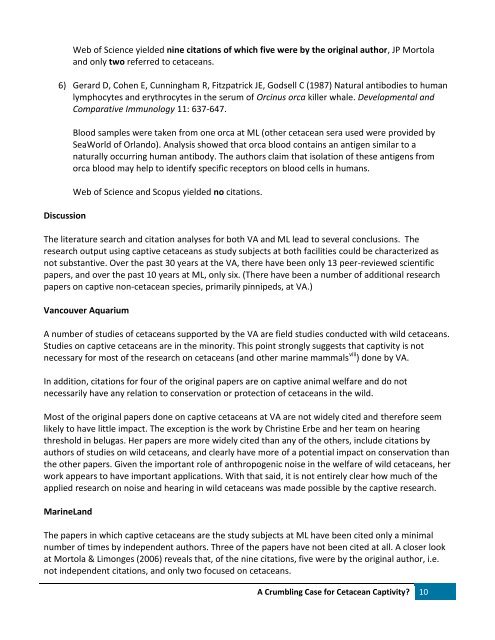A CRUMBLING CASE FOR CETACEAN CAPTIVITY?
MM-Education-and-Conservation-Report-Dec-9-2016-fi
MM-Education-and-Conservation-Report-Dec-9-2016-fi
You also want an ePaper? Increase the reach of your titles
YUMPU automatically turns print PDFs into web optimized ePapers that Google loves.
Web of Science yielded nine citations of which five were by the original author, JP Mortola<br />
and only two referred to cetaceans.<br />
6) Gerard D, Cohen E, Cunningham R, Fitzpatrick JE, Godsell C (1987) Natural antibodies to human<br />
lymphocytes and erythrocytes in the serum of Orcinus orca killer whale. Developmental and<br />
Comparative Immunology 11: 637-647.<br />
Discussion<br />
Blood samples were taken from one orca at ML (other cetacean sera used were provided by<br />
SeaWorld of Orlando). Analysis showed that orca blood contains an antigen similar to a<br />
naturally occurring human antibody. The authors claim that isolation of these antigens from<br />
orca blood may help to identify specific receptors on blood cells in humans.<br />
Web of Science and Scopus yielded no citations.<br />
The literature search and citation analyses for both VA and ML lead to several conclusions. The<br />
research output using captive cetaceans as study subjects at both facilities could be characterized as<br />
not substantive. Over the past 30 years at the VA, there have been only 13 peer-reviewed scientific<br />
papers, and over the past 10 years at ML, only six. (There have been a number of additional research<br />
papers on captive non-cetacean species, primarily pinnipeds, at VA.)<br />
Vancouver Aquarium<br />
A number of studies of cetaceans supported by the VA are field studies conducted with wild cetaceans.<br />
Studies on captive cetaceans are in the minority. This point strongly suggests that captivity is not<br />
necessary for most of the research on cetaceans (and other marine mammals viii ) done by VA.<br />
In addition, citations for four of the original papers are on captive animal welfare and do not<br />
necessarily have any relation to conservation or protection of cetaceans in the wild.<br />
Most of the original papers done on captive cetaceans at VA are not widely cited and therefore seem<br />
likely to have little impact. The exception is the work by Christine Erbe and her team on hearing<br />
threshold in belugas. Her papers are more widely cited than any of the others, include citations by<br />
authors of studies on wild cetaceans, and clearly have more of a potential impact on conservation than<br />
the other papers. Given the important role of anthropogenic noise in the welfare of wild cetaceans, her<br />
work appears to have important applications. With that said, it is not entirely clear how much of the<br />
applied research on noise and hearing in wild cetaceans was made possible by the captive research.<br />
MarineLand<br />
The papers in which captive cetaceans are the study subjects at ML have been cited only a minimal<br />
number of times by independent authors. Three of the papers have not been cited at all. A closer look<br />
at Mortola & Limonges (2006) reveals that, of the nine citations, five were by the original author, i.e.<br />
not independent citations, and only two focused on cetaceans.<br />
A Crumbling Case for Cetacean Captivity? 10


